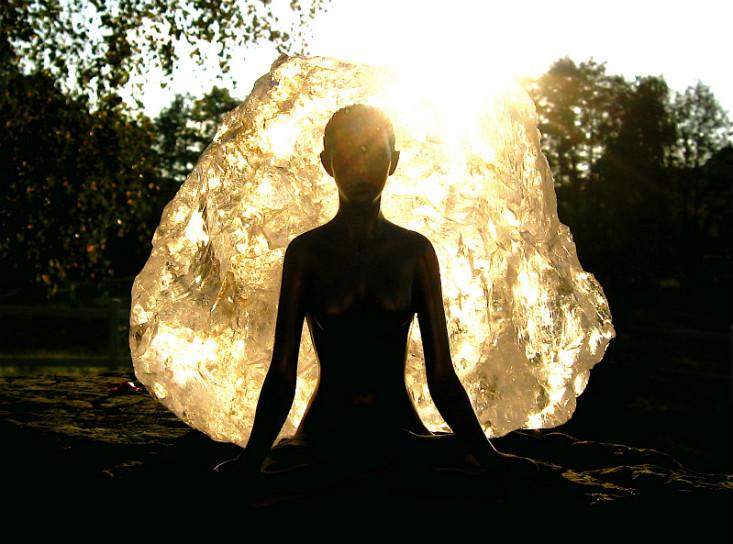After five years of practicing meditation, subject number 99003 began to see the lights. “My eyes were closed,” he reported, “[and] there would be what appeared to be a moon-shaped object in my consciousness directly above me, about the same size as the moon if you lay down on the ground and look into the night sky. It was white. When I let go I was totally enveloped inside this light… I was seeing colors and lights and all kinds of things going on… Blue, purple, red. They were globes; they were kind of like Christmas-tree lights hanging out in space, except they were round.”
Subject 99003 described these experiences to Jared Lindahl, a researcher from Warren Wilson College in Asheville, North Carolina, who has spent years scientifically studying meditation. He and his team are the midst of a large study on meditators and their experiences, and in a recent paper they homed in on a peculiar experience many of them share: mysterious lights that appear in their mind’s eyes as they practice.
To figure out just where these lights might be coming from, Lindahl and his team talked to 28 meditators for an average of 77 minutes each. Nine of them reported “light experiences,” with descriptions much like subject 99003’s. “Sometimes there were, oftentimes, just a white spot, sometimes multiple white spots,” one said. “Sometimes the spots, or ‘little stars’ as I called them, would float together in a wave, like a group of birds migrating, but I would just let those things come and go.”
Another said: “In concentration I’ve had rays of white light that go through everything. They’re either coming from behind me somewhere or coming out of the object that I was concentrating on… I saw it with my eyes open and it wasn’t really seeing it was something else, even though I still was perceiving that I was there.”
Buddhist literature refers to lights and visions in myriad ways. The Theravada tradition refers to nimitta, an vision of a series of lights seen during meditation that can be taken to represent everything from the meditator’s pure mind to a visual symbol of a real object. In one Buddhist text, called The Path of Purification, the nimitta is described this way:
It appears to some as a star or cluster of gems or a cluster of pearls, […] to others like a long braid string or a wreath of flowers or a puff of smoke, to others like a stretched-out cobweb or a film of cloud or a lotus flower or a chariot wheel or the moon’s disk or the sun’s disk.
Other Buddhist traditions also refer to lights during meditation, but Lindahl points out in the paper that “there is no single, consistent interpretation of meditation-induced light experiences in Buddhist traditions.” And yet the appearance of lights isn’t a fluke occurrence—it’s something that many meditators experience, and that many traditions have tried to incorporate and explain.
“Sometimes the spots, or ‘little stars’ as I called them, would float together in a wave, like a group of birds migrating, but I would just let those things come and go.”
So where are these lights coming from? They’re clearly not real, physical lights dancing in front of the meditator’s face, but rather a construction of the idle, meditating brain. What is it about meditation that opens the brain up to these kinds of hallucinations?
To answer that question, Lindahl and his team looked for occasions where the descriptions he gathered from meditators intersected with descriptions of neurophysiological disorders. They found that both the first-person accounts and the Buddhist literary descriptions of these lights intersected pretty well with the experiences of people undergoing the intentional practice of sensory deprivation.
Hallucinations are relatively well-documented in the world of sensory deprivation, and they dovetail with the lights seen by meditators. Where meditators describe jewel lights, white spots and little stars, those under sensory deprivation sometimes describe dots and points of light. Where meditators see shimmering ropes, electrical sparks, and rays of light that go through everything, the sensory deprived might see visual snow, bright sunsets, and shimmering, luminous fog. Neuroscientists think that when the eyes and ears are deprived of input, the brain becomes hypersensitive and neurons may fire with little provocation, creating these kinds of light shows. Lindahl suspects that the lights that meditators see are the result of the same phenomenon—that meditating is itself a mild form of sensory deprivation.
In some ways, this is not surprising. Meditation often involves being alone, in a quiet, dimly lit room. Some Tibetan Buddhists practice what’s called “mun mtshams,” or “dark retreat,” in which they close themselves off in the dark. And it’s not just about the physical spaces where meditation happens—many forms of meditation are focused on isolating a single stimulus and shutting out everything else, a kind of mental sensory deprivation. By focusing on breath, a specific vision, a single object, or something else as they get into the zone, meditators are “guarding the sense doors” from the rest of the world. This may be an ancient trick for creating a space of intentional sensory deprivation and opening oneself up to the dazzling light show that often follows.
Rose Eveleth is Nautilus’ special media manager.































